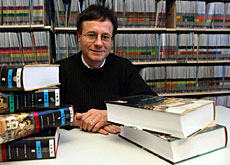
Historical dictionary seeks a future

The Swiss government is set to outline in parliament this week its plans for the national Historical Dictionary, a project researchers say is unique in its scope.
With politicians concerned all work will cease once the project ends, swissinfo caught up with its leader Marco Jorio, to see how the dictionary can build on its unexpected success, especially on the internet.
The fifth volume out of 13 of the dictionary will eventually count was published in November. There is still plenty to be done, but much of the hard work will soon be over with 80 per cent of the articles already written.
With the project – which began in 1988 and is valued at SFr100 million ($84 million) – due to end in 2014, some parliamentarians are concerned what will happen to the data that was compiled.
The project is considered unique because nowhere in the world has anyone attempted to put together this type of dictionary in three languages as well as make it available via internet.
By the time it is finished, there will be 115,000 articles accessible online. Politicians would like to see the project become an information and documentation centre about Swiss history, protecting its legacy.
swissinfo: How successful has the electronic version of the dictionary been?
Marco Jorio: You read on internet more than half the articles that have been written so far. More and more people are consulting the site. In the past two years, the number of visitors has more than tripled. A lot of people seem to use the electronic dictionary to find historical information about Switzerland.
swissinfo: The electronic version also has the advantage of being free, unlike the print version that costs SFr300 ($252).
M.J.: That’s true, but I don’t think that’s the only reason. There are plenty of people – youngsters and people of middle age especially – who use internet to get information. The electronic version costs nothing. Since it is funded by the government, and therefore by taxpayers, there should be some form of payback.
swissinfo: Should we be concerned about the future of the electronic version?
M.J.: Of course. For the moment, parliament and the government have only agreed to pay the first phase of the project, which covers the publication of 13 volumes in German, French and Italian.
We don’t know what will happen after that. The worst case scenario would be for the government to stop all funding, which also involve shutting down our database. It would be bad idea. It would be like investing in a bridge – and we are a bridge between researchers and the public – and then not paying for its upkeep. You have to get something out of this SFr100 million investment.
swissinfo: One idea is to turn the project into a historical information and documentation centre. What do you think of this idea?
M.J.: In a sense, that’s what we already do. The most urgent thing to do was put together the dictionary. But in 1987, it was already suggested to create a centre that historians have been demanding for the past 30 years.
If the project moved in this direction, it wouldn’t be just to edit and update the dictionary. We could develop new tools such as a new Swiss atlas, a database of family names or regularly publish a catalogue of historical source material. A centre would also have to help fill all the gaps in our historical research and communicate the results of historians’ work to the public.
swissinfo: This centre could also kindle interest in the humanities and history. Are these fields of research somewhat lethargic at the moment?
M.J.: You only have to look at the numbers to see the problem. Humanities represent 60 per cent of students at university, but only get a fifth of the funding from the Swiss National Science Foundation.
Humanities have also fallen behind if compared with what’s going on abroad. We need an infrastructure that can compile all the information that is being made available. We are communicating far too much in a piecemeal fashion for the moment.
swissinfo, Olivier Pauchard
The Historical Dictionary of Switzerland is:
13 volumes in German, French and Italian.
36,000 articles for the print edition, with a total of 10,600 pages.
8,500 illustrations.
By the end of August, nearly 80 per cent of the articles had been written.
Nearly 60 per cent of these are already online.
There 2,500 authors, 40 editors, 120 scientific advisors and 75 translators.
Early in 2004, there were 400,000 monthly views on the dictionary website.
Today, that figure has grown to 1.8 million.

In compliance with the JTI standards
More: SWI swissinfo.ch certified by the Journalism Trust Initiative































You can find an overview of ongoing debates with our journalists here . Please join us!
If you want to start a conversation about a topic raised in this article or want to report factual errors, email us at english@swissinfo.ch.